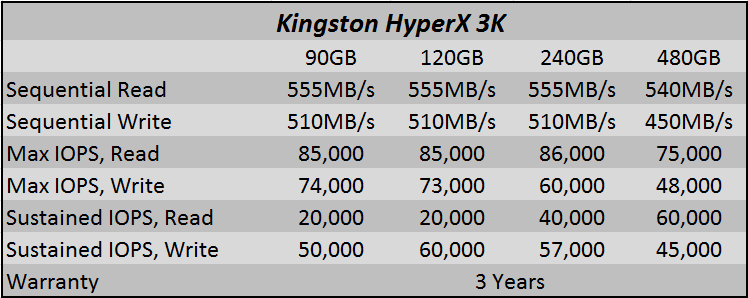Our SSD report today examines the Kingston HyperX 3K 240GB SATA 3 SSD, ‘3k’ signifying Kingston’s move to the more economical 3k PE (program/erase cycles) rated NAND for increased consumer value.
For the typical consumer, this will mean little as their new HyperX 3k will still last years, however, interestingly enough, Kingston claims no performance loss for the better value and this is definitely encouraging.
As reference, feel free to refer back to our Kingston HyperX SSD Review of months past as there are only two minor difference between the two, this being the firmware revision and the fact that the original contained the longer lasting 5k PE NAND flash memory. To clarify, 5K PE means the disk is expected to last for 5000 full writes of the disks capacity.
INTRODUCTION
To start the ball rolling, Kingston deserves credit for their approach to consumer value as they could have created an enthusiast product with less expensive asynchronous IMFT flash rather than the their choice of the new premium Intel 3k synchronous memory.
Doing so would have meant a sharp reduction in performance, though the price would have been much lower. When the SF-2281 first appeared, products using asynchronous and the faster synchronous NAND varieties were often neck-and-neck in price as volatile flash pricing changed on a daily basis. Today, asynchronous memory SSDs are very inexpensive, but increasingly less desirable by users in the know.
Fortunately for budget minded enthusiasts, the new HyperX 3K keeps the same performance at a lower price point by using IMFT 3,000 PE (program/erase) cycle rated NAND. For a lower price point, you get the same level of performance, just less endurance.
SPECIFICATIONS
 There are a few performance differences and small variations in sustained and max IOPS when comparing old to new, though this could be the result of firmware revisions used for testing than choice of flash. The 3K HyperX is shipping with 5.01ABB0 LSI SandForce reference firmware, a much newer release.
There are a few performance differences and small variations in sustained and max IOPS when comparing old to new, though this could be the result of firmware revisions used for testing than choice of flash. The 3K HyperX is shipping with 5.01ABB0 LSI SandForce reference firmware, a much newer release.
The two HyperX drives certainly have a unique chassis aesthetic, with heavy brushed metal inserts on the top reflecting the HyperX design language. The 5K version is blue while the 3K has black trim. Both are quite attractive and have 9.5mm Z-heights, though making a 7mm design might have been a better way to ensure compatibility with todays thinner laptops.
PACKAGE CONTENTS
This HyperX 3K packaging included the HyperX 3K SSD, a deluxe installation kit with screwdrivers, SATA cable, installation bracket, USB2 enclosure and Acronis Data Migration Software.
The regular HyperX, signified as 5K for the purposes of the review forr its 5,000 PE cycle NAND, is capable of greater endurance, or more Total Bytes Written (TBW). Both old and new should still have 5+ years of service, especially with SandForces compression technology reducing the physical amount of NAND writes. Both HyperX drives have SandForces RAISE enabled to help facilitate recovery in the event of a die failure.
Kingston has maintained a unique relationship with Intel over the years. At the time of the original HyperX 5k release, it was the only SATA III SSD on the market using Intels special stash of premium NAND flash memory. That memory, usually reserved for Intels own drives, was responsible for the original HyperX SSDs higher 5,000 PE rating. Most 25nm ONFI NAND flash memory is rated at 3,000 PE cycles, thus providing the HyperX 5K with a distinct advantage in longevity over it’s peers. That flash is still not as competitive in price as that of the majority of 25nm ONFI flash in use today.

 The 16 packages of Intel 29F16B08CCME3 25nm NAND are used in several products, from the ADATA XPG SX900 to the OCZ Vertex 4. Theyre officially rated for 3,000 program/erase cycles. Each of the 16 packages is composed of two 8GB (64gbit) die for a total capacity of 256GB. Space after partitioning and formatting is 224 and cooling of the SSD components is facilitated by a pink thermal pad on both sides of the PCB.
The 16 packages of Intel 29F16B08CCME3 25nm NAND are used in several products, from the ADATA XPG SX900 to the OCZ Vertex 4. Theyre officially rated for 3,000 program/erase cycles. Each of the 16 packages is composed of two 8GB (64gbit) die for a total capacity of 256GB. Space after partitioning and formatting is 224 and cooling of the SSD components is facilitated by a pink thermal pad on both sides of the PCB.
When talking endurance, its important to remember two things: PE cycle ratings are extremely conservative and client/consumer workloads are very gentle on SSDs. Kingston rates the 3K series by Total Bytes Written. These figures may look low, but theyre generated via full-span random writes (random 4K writes to all LBA to the drive), the kind of punishment which generates the most write amplification. A normal enthusiast workload could just ballpark a figure of 10x the TBW figure to get a scale of how much writing a drive could take over a service life when considering endurance.
 The SSD Review The Worlds Dedicated SSD Education and Review Resource |
The SSD Review The Worlds Dedicated SSD Education and Review Resource | 
my kingston sh103s3120g temperature is always at 45C. it’s that ok?i use it in a laptop.